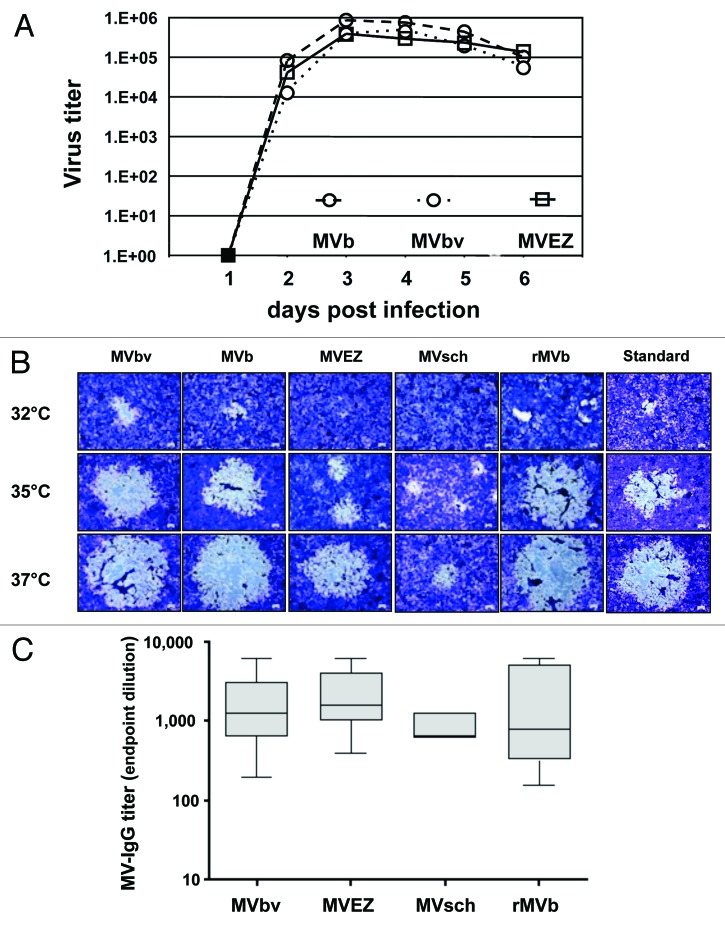Abstract
The measles virus vaccine (MVbv) is a clinically certified and well-tolerated vaccine strain that has been given both parenterally and mucosally. It has been extensively used in children and has proven to be safe and effective in eliciting protective immunity. This specific strain was therefore chosen to generate a measles viral vector. The genome of the commercial MVbv vaccine strain was isolated, sequenced and a plasmid, p(+)MVb, enabling transcription of the viral antigenome and rescue of MVb, was constructed. Phylogenic and phenotypic analysis revealed that MVbv and the rescued MVb constitute another evolutionary branch within the hitherto classified measles vaccines. Plasmid p(+)MVb was modified by insertion of artificial MV-type transcription units (ATUs) for the generation of recombinant viruses (rMVb) expressing additional proteins. Replication characteristics and immunogenicity of rMVb vectors were similar to the parental MVbv and to other vaccine strains. The expression of the additional proteins was stable over 10 serial virus transfers, which corresponds to an amplification greater than 1020. The excellent safety record and its efficient application as aerosol may add to the usefulness of the derived vectors.
Keywords: recombinant measles virus, viral vectors, live-attenuated vaccines
Introduction
The sustained efforts to develop effective vaccines against diseases such as AIDS,1,2 malaria3,4 and tuberculosis5,6 led to a wide range of innovative strategies for the development of vaccines. Within the past 15 y, a variety of viruses have been investigated for their ability to express antigens derived from these pathogens and to induce stronger and longer-lasting humoral and cellular immune responses.7,8 Extensive experience has been gathered using non-replicating viral vectors. However, replication-competent live attenuated recombinant viruses, particularly those preferentially targeting professional antigen-presenting cells may have greater potential as vector backbones.7-10
Ideally, recombinant vaccines should be safe, induce humoral and cellular immune responses against the transgene, and should provide long-lasting protection.11 Measles virus (MV) vaccine has been shown to perfectly fulfill these requirements and is thus suitable to be used as a vector.9,12 Reverse genetics technology using a helper-cell-based rescue system13,14 allowed the generation of a variety of live recombinant MV (rMV) able to stably express heterologous proteins. Numerous investigations using transgenic mice susceptible for MV infection, and experiments using macaques confirmed that these rMV induce long-lasting humoral and cellular immune responses against the MV itself and against the heterologous proteins.8,11,12,15-21
Although the generation and application of rMV vaccine candidates is feasible today, a possible drawback could be a pre-existing immunity in naturally infected or vaccinated population. However recently, the aerosol immunization route using different MV vaccines has been extensively studied to determine its potential to circumvent measles pre-immunity.2,22,23 The vaccine strain (MVbv) applied as an aerosol vaccine, has revealed particularly high efficacy by inducing or enhancing, respectively, neutralizing anti-MV antibody titers in seronegative and seropositive children.24,25 These findings suggest that MVbv can circumvent measles pre-immunity when applied mucosally.
This report presents the generation of a cloned version of the MVbv strain, and characterizes its genetic-, biochemical- and immunological features. MVbv vector is shown to express one or several foreign antigens and induce significant immune responses against these antigens, while maintaining the MVbv strain characteristics.
Results
Sequence and characteristics of MVbv
The commercial MVbv is an attenuated live strain used in the vaccination programs world-wide. In order to develop a MV vector system using this commercial strain, the genome was fully sequenced from a batch of master seed viruses and of the working seed lot of the MVbv was performed. As expected, no sequence differences were observed between MVbv and the master seed and working seed lots. The obtained sequence was taken as standard for the cloning of the plasmid p(+)MVb which encompasses the entire MVbv antigenome. The MVbv sequence was also compared with the available published sequences of MVEZ, MVsch, MV Rubeovax, and MV AIK-C (Table 1).
Table 1. Comparison of the nucleotide and amino acid sequences of different MV vaccine strains.
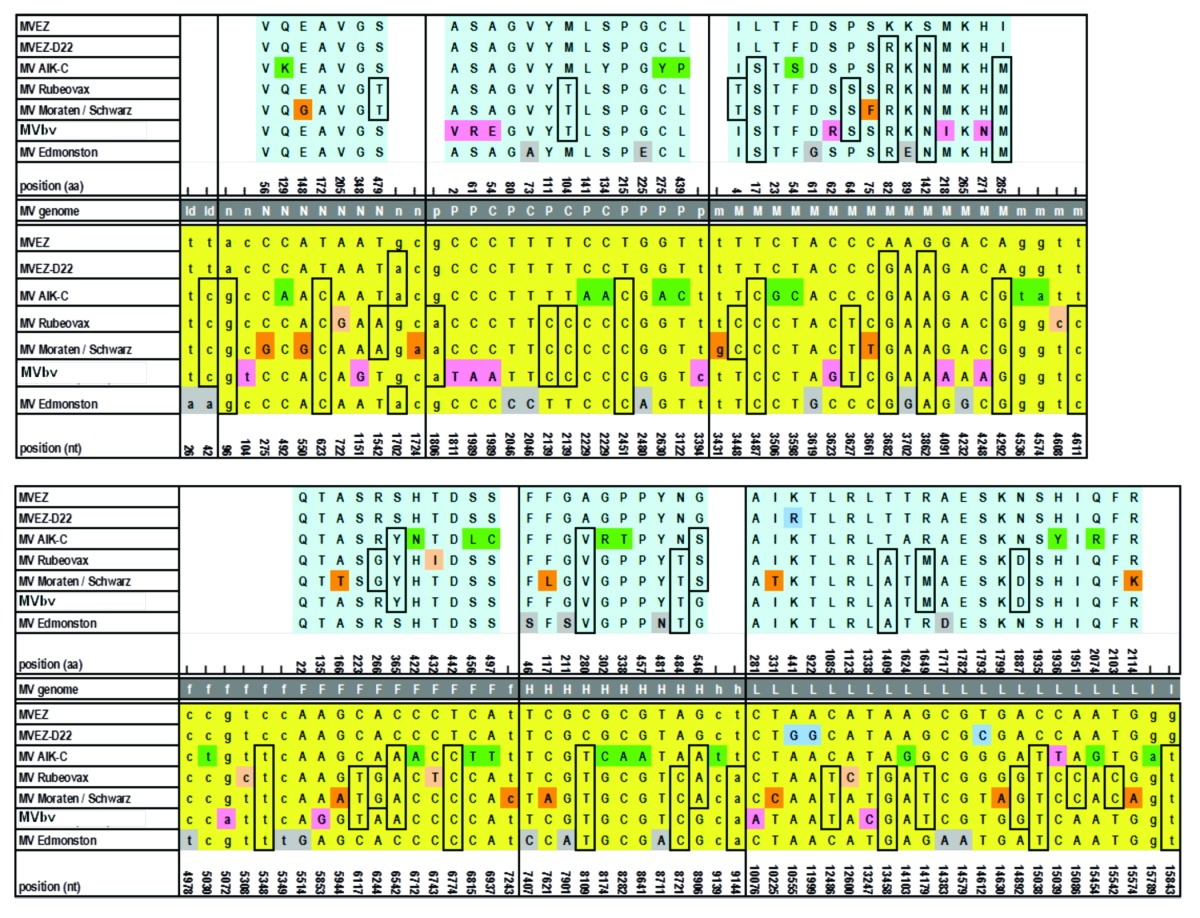
The nucleotide (nt) and the corresponding amino acid (aa) differences are shown in this table. Unique nucleotides are shown in colored boxes. The numbers indicate the position of the nt within the antigenome and of the aa within the proteins, respectively. Capital letters indicate the open reading frame (ORF), and small letter is the non-translated region within a gene.
The sequence analysis of the genome of MVbv revealed not less than 38 nucleotide deviations in comparison to the MVEZ seed D22 (MVEZ-D22) virus genome.30 Additionally, 38 base substitutions were found when compared with the previously available MVEZ genome sequence deposited at NCBI (AF26629031). In contrast, the MVEZ-D22 and the MVEZ (AF266290) genomes differed by only 6nt; the difference may be explained by the cultivation of the MVEZ strain for some passages in animal cells (i.e., Vero cells) instead of human diploid cells to get sufficient material for sequencing analysis.31 However, similarly to the divergence of either MVEZ-D22 or MVEZ from MVsch or the parental MV Edmonston strain, the MVbv vaccine considerably differed from MVsch by 29nt or from the parental MV Edmonston by 36nt (Table 1).
A total of 12 nucleotide deviations were found to be unique to the MVbv strain, as compared with the genomes of other relevant MV vaccine strains, including a wild type isolate. The coding regions were affected by 9 mutations (4 were silent mutations) leading to a total of 8 amino acid deviations (P ORF: 2 amino acid changes; V ORF: 2 amino acid changes; C ORF: 1 amino acid change; M ORF: 3 amino acid changes). Additionally, three unique deviations were found in the untranslated regions of the N, P and F genes, respectively.
A phylogram, using the parental MV Edmonston strain as the out-group, indicates the relationships between a subset of relevant MV vaccine strains including MVbv (Fig. 1). The MVbv strain thus constitutes an evolutionary branch within the MV vaccine family (Fig. 1).
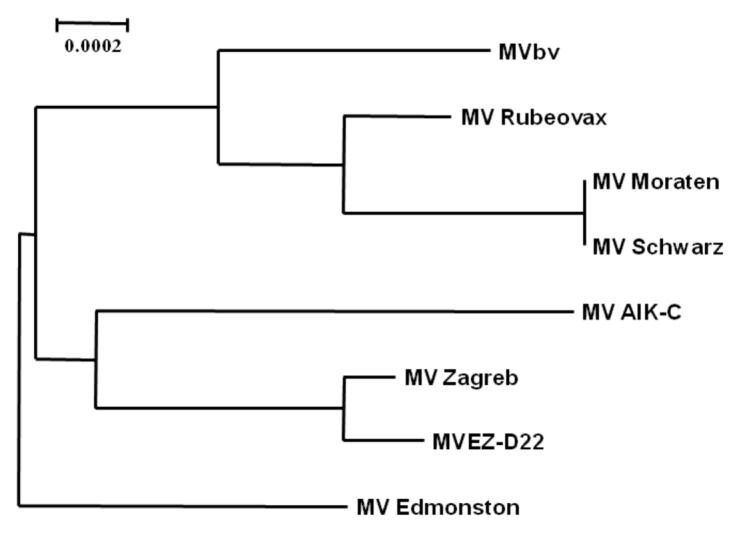
Figure 1. Phylogenetic analysis of MVbv. Sequences of different MV strains were aligned with ClustalW and a phylogram was generated by the neighbor-joining method using the parental MV Edmonston sequence as an out-group. The scale (0.0002) indicates the number of substitutions per nucleotide.
Construction of p(+)MVb and rescue of cloned and recombinant MVb viruses
The plasmid p(+)MVb, was cloned by RT-PCR from a batch of master seed viruses exactly as previously reported by Radecke et al., 1995. To generate recombinant MV, p(+)MVb was modified first by insertion of an additional transcription unit (ATU) at position 2 between the P and M genes.20,21 Finally, the GFP ORF was replaced by ORFs derived from other pathogens, here by the HIV-1 clade B env . This recombinant, rMVb2-HIV-env (in short rMVb), and the corresponding empty vector, MVb, were readily rescued, expanded and analyzed for transgene stability, protein expression and immunogenic potential.
Propagation kinetics, cytopathogenicity and immunogenicity
Growth kinetics of the cloned MVb was compared with the parental MVbv and to a commercial MVEZ vaccine virus (since these viruses are adapted to MRC-5 cells). No significant growth difference was observed (Fig. 2A), even when grown at different temperatures. In order to analyze the fitness of the virus for production, MVb, MVbv and MVEZ were expanded in roller flasks using media, cells and protocols for GMP measles vaccine production. The corresponding titers of single harvests were comparable among all viruses included in the assay, indicating similar fitness and infectivity potential of the cloned MVb. End titers of cell free viruses produced exceeded 106 pfu/ml (not shown).
Figure 2. Comparison of the cloned MVb with different MV vaccine strains and a recombinant virus. (A) Growth kinetic analyses. Comparison of the propagation kinetics of the standard MVbv, cloned MVb and the MVEZ virus on MRC-5. Cell-free virus preparations from infected cells were collected at daily intervals and virus titers were determined by plaque assay. (B) Phenotypic assessment of various MV vaccine strains (MVbv, MVb, MVEZ, MVsch, rMVb and standard MV). Vero cells were infected, incubated at different temperatures, and the phenotype was evaluated according to the cytopathic effect. (C) Transgenic mice expressing human CD46 were immunized i.m with 1 × 105 pfu rMVb MVbv, MVEZ and MVsch. Measles end point titers are shown on a logarithmic scale.
The cytopathic phenotype of various MV vaccine strains was determined at different temperatures (32°C, 35°C and 37°C). As shown in Figure 2B, clear phenotype differences between the MV strains were observed. As expected, the MVbv, MV-standard vaccine, MVb, and rMVb displayed cytopathic effect that was not significantly different from the MVEZ strain. The most significant differences were observed with MV-Schwarz (MVsch) that was characterized by very small syncytia.
Next, the immunogenicity of the different vaccine strains was compared with the rMVb vector. Measles-susceptible but immune competent transgenic mice (hCD46tg) were immunized intramuscularly with a single dose of 1 × 105 pfu with different MV vaccine strains (MVbv, MVEZ, MVsch), and a recombinant MV (rMVb). Median anti-MV IgG titers (around 1:1,000) were reached after 4 weeks for all vaccine strains including rMVb. No significant differences between the groups were measurable (Fig. 2C). These results demonstrated an equivalent immunogenic potential of the MVb and rMVb as compared with different measles strains, and documents in vivo functionality and immunogenicity.
Transgene stability and protein expression of MVb-based recombinant vector
Sequencing, immunofluorescence and western blot analysis were used to ascertain the expression activity and the genetic stability of the inserted transgenes, rMVb-HIV-env was serially passaged 10 times on MRC-5 cells, ten single syncytia were picked from each of passages 1 and 10, and tested by sequencing and immunofluorescence (IF). The sequence of the HIV-env RNA derived from each syncytium revealed 100% transgene stability (results not shown). IF analysis showed that all syncytia induced by the rMVb viruses, of passages 1 and 10, expressed the HIV-env protein. In contrast the syncytia induced by MVb viruses did not express env protein (Fig. 3A). SDS-PAGE analysis also confirmed proper protein expression. Since the cloned HIV-env gene did not encode the cytoplasmic and transmembrane domains, the resultant protein was also detected in the medium of infected cells; the different bands indicating the cell-associated protein are due to different stages of glycosylation (Fig. 3B).
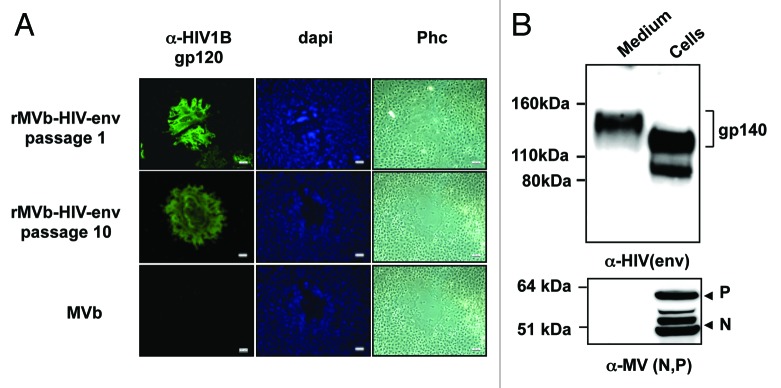
Figure 3. Transgene expression. Expression of the transgene was assessed by (A) immunofluorescence. Recombinant MV expressing HIV env (see M&M) was passaged 10 time on MRC5 cells, the resultant virus shed from passage 1 and 10 were analyzed by immunofluorescence, Dapi staining and phase contrast (Phc). Only positive expressing HIV env were formed by passaged viruses, and only negative syncytia by the control MVb (> 100 syncytia were counted). Images show typical syncytia formed by passaged viruses. (B) Antigen expression by rMVb was analyzed by western blots against HIV-env and measles N and P protein are shown. Note: mature HIV env (gp-140) is detected in the medium because it is a secreted protein. In the cell, different forms of the protein are revealed due to various maturation stages of the glycoprotein.
In conclusion, we observed a 100% genetic stability of the transgene after 10 passages (equivalent of > 1020 of virus amplifications in cell culture).
Humoral immune response induced against the transgene after mucosal immunization
One of the main qualities of the MVbv strain is its capacity to stimulate the immune system upon mucosal immunization. Mice were therefore immunized intranasally with 1 × 105 pfu of rMVb2-HIV-env; a UV-inactivated preparation was used as control. hCD46 transgenic mice induced significant levels of anti-measles and anti-HIVenv antibodies after a single intranasal immunization. As can be seen in Figure 4, the vector induced humoral responses against both MV and the transgene. The titers against MV were up to 1:1,000 whereas the response against the transgenic HIV-env was around 1:200. The UV-inactivated rMVb2-HIV-env virus was not able to stimulate any immune response against HIV-env, indicating that triggering immune responses requires virus replication.
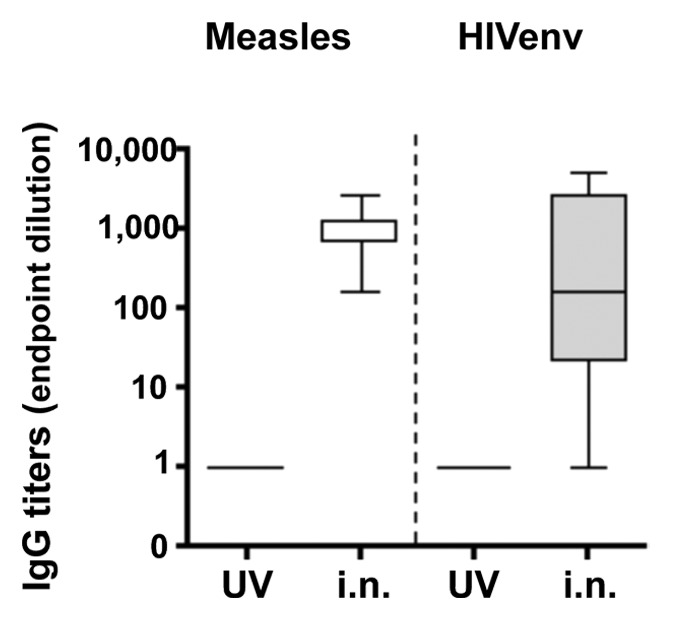
Figure 4. Induction of humoral immune responses upon intranasal application. To test the ability of rMVb vectors to induce a humoral immune response against HIV-env and MV-specific antigens, respectively, rMVb2-HIV-env was applied at 1 × 105 pfu i.n; a UV-inactivated preparation was used as control. Anti-measles and anti-HIV-env antibody titers, respectively, are represented as in Figure 2C.
Discussion
The measles vaccine strain (MVbv) was cloned into a plasmid which allows the rescue of MVb. This antigenomic plasmid was then modified by insertion of an artificial ATU, to develop a novel vector system for the expression of heterologous antigens, to pave the way toward the development of new preventive or therapeutic recombinant measles virus (rMVb) vaccines.
MVbv has the advantage of being a replication efficient but live-attenuated vaccine strain with an excellent record of safety and efficacy.2,23,24 It is produced in human diploid cell, which reduces potential allergic side effects and manufacturing costs. MVbv induces long-lasting humoral and cellular immune responses, and can be applied parentally or as aerosol vaccine. Interestingly, this strain is different from the other vaccine strains and stays as a separate branch, which may explain its unique features as a vaccine strain.
The possibility to administer this vaccine by aerosol is important for efficiently circumventing systemic MV pre-immunity present in the large parts of the population. Children vaccination trials have shown that aerosol administration of MVbv induced priming of seronegative- and boosting of seropositive children, more efficiently than parenteral administration.24,25 In addition, using the cholera toxin B subunit as a model, nasal immunization has been shown to results not only in antibody responses in the upper airway mucosa, but also to induce substantial IgA and IgG antibody responses in the human cervicovaginal mucosa; these findings were confirmed with other antigens.32-34 These characteristics may be highly relevant when designing a vaccine against HIV-1.
The generated rMVb containing a HIVenv clade B as a transgene showed the efficacy of the novel vector backbone for potential vaccines. The newly generated MVb show the same MV-characteristics as the parental MVbv, and exhibits similar growth kinetics, viral fitness, and immunogenicity potential as the commercial Schwarz and MVEZ vaccines. Differences in the sequence and cytopathology were observed when compared with these vaccine strains, which may reflect their different phylogenic evolution.
In cell culture the rMVb2-HIV-env showed stable transgene and protein expression after 10 passages. To test the immunogenicity of this construct, first the aerosol route was attempted, which failed due to technical problems with the applicator diminution required for mice. Intranasal immunization drop application was chosen as alternative mucosal immunization. To note, we have previously used a transgenic mouse model, which not only expressed the human CD46 MV-receptor, but was also immune compromised by lacking the Interferon type I receptor (IFNAR−/−hCD46tg).35 In this study we used the immune competent mice (hCD46tg) because the responses elicited in immune compromised mice may be aberrant (Marty et al., in preparation). Intranasal application of rMVb2-HIV-env elicited a humoral immune response against HIVenv protein and against MV itself, showing its potential as a bivalent vaccine.
In conclusion, the cloned MVb virus proved to be genetically stable, displayed similar growth characteristics and immunogenic potential as the commercial MVbv that has been used for vaccine campaigns in many countries. When used as a vector, rMVb is able to stably express heterologous genes and to stimulate the immune system against the vector and the inserted gene products after an intranasal application. It remains to be determined whether intranasal application of rMVb in MV-pre-immune animals would elicit significant boost of anti MV antibodies and subsequently induce antibodies against the vectored antigen(s).
Materials and Methods
Cells and viruses
Vero cells (African green monkey kidney cells) were maintained with MEM/880 NEAA medium supplemented with 5% FBS (Gibco), L-glutamine (0.58 mg/ml) and gentamycin (0.05 mg/ml). The MV rescue cell line, 293–3-46 (human embryonic kidney cells),14 was cultivated in DMEM containing 10% FBS and 1.2 mg/ml of geneticin (G418, Invitrogen). MRC-5 cells were cultured in production media supplemented with 10% FBS. All cell cultures were incubated at 37°C with 5% CO2. Aliquots of master and working seed measles viruses vaccine were obtained from Drs Reinhard Gluck and Peter Stettler, Berna Biotech LTD, here simplified by MVbv. The Edmonston Zagreb (MVEZ) and Schwarz (MVsch) vaccine strains were purchased.
Sequence analysis of MVbv and construction of plasmid p(+)MVb
The measles vaccine virus (MVbv) from the master seed was sequenced after the generation of cDNA from the original genomic RNA. The genomic RNA was isolated (RNeasy, Qiagen) and reverse transcribed using random hexamers for the first-strand cDNA synthesis (cDNA Cycle Kit, Invitrogen). PCR amplification was done using a set of 27 oligonucleotide pairs covering the entire viral genome to generate overlapping fragments of approximately 500 to 700 bp (Accuprime Pfx polymerase, Invitrogen). Amplified products were used for sequencing (Microsynth), and data were analyzed using appropriate software. For the phylogenetic analysis, sequences of different MV strains were aligned with ClustalW (http://www.ebi.ac.uk/clustalw/), and a phylogram was generated by the neighbor-joining method using Njplot (http://pbil.univ-lyon1.fr/software/njplot.html). The parental MV Edmonston sequence was defined as the out-group.
Generation of the cloned MVb virus
Cloned MVb was rescued using the 293–3-46 helper cell line, as described previously.14 Single syncytia were picked and stored at -80°C until viruses were used for expansion on MRC-5 cells.
Insertion of HIV env transgene and rescue of rMV
The HIV-1 plasmid containing clade B env was a kind gift of G. Nabel, Vaccine Research Centre, NIH, USA. Cloning of HIV transgenes and rescue of the corresponding rMV-HIV-1 viruses was done as previously described.14
Virus propagation and expansion
Virus expansion was done according to standard procedures.21 Briefly, single syncytia were used to infect MRC-5 cells in 36 mm2 dishes. Further expansion of the virus was done in successively larger culture flasks (Corning). Individual virus harvests were collected and tested for potency. Harvests were clarified by filtration, aliquoted, and then stored at -80°C. Virus titers were determined by standard plaque assay on Vero cells.21
Virus growth kinetics
Confluent cultures of MRC-5 cells were inoculated with MVbv, MVEZ, or rMVb at an MOI of 0.05. After one hour incubation, complete MRC-5 medium was added. Viruses were incubated at 35°C with 5% CO2 for 6 d. Cell-free virus fraction was subjected to MV plaque titration assay.20,26
Sequence determination of transgenes after 10 serial passages of rMVb
To determine transgene stability rMVs were serially passaged on MRC5 cells up to 10 passages. The potency of virus shed after each passage was determined by plaque assays. Amplification was determined at an average of 100 per passage. Single syncytia from passages 1, 5 and 10 were taken and virus amplified for sequencing of the transgene using specific primers.
Immunofluorescence and western blot
Vero cells cultured on glass slides were infected with MVbv, MVb or rMVb2-HIV-env. Cells were then fixed with 4% paraformaldehyde and permeabilized with ice-cold methanol. Unspecific interactions were blocked with 0.5% BSA in PBS. Mouse anti-MV (N, P) serum and sheep anti-gp120 serum (AIDS Research and Reference Reagent Program) were used as primary antibodies. Adequate secondary antibodies-Cy3 or Alexa 488-conjugated (Milian or Invitrogen, respectively) were used. Syncytia were finally analyzed under the microscope and counted for statistical relevance.
Transgene expression was also analyzed by western blot. Briefly, infected cells were lysed in lyses buffer (1% NP-40 / 150 mM NaCl / 50 mM TRIS-HCl pH 8) containing a protease inhibitors cocktail (Complete Mini, Roche Diagnostics GmbH). Total cell extract was resolved on NuPAGE 4–12% Bis-Tris gels (Invitrogen) using MOPS-containing running buffer. Proteins were transferred on nitrocellulose membranes by wet blotting. rMVb2-HIV-env was detected using antisera directed against HIV-1 gp120. Additionally, the MV nucleocapsid (N) and phosphoprotein (P) were detected with a specific antiserum.27
Cytopathic effect of different MV
To compare the cytopathic effect of different MV strains, plaque titration assay was performed according to standard procedures.27 Different growth temperatures were tested (32°C, 35°C and 37°C) to monitor the plaque morphology. Briefly, confluent Vero cells were infected with the different MV strains and kept for 7 d at different temperatures. The cell monolayer was then fixed and stained with Crystal Violet solution and pictures of the syncytia were taken using a Leica microscope.
CD46 transgenic mice and immunizations
The mice were kept under specified pathogen-free conditions. The Swiss Federal Veterinary Office for Animal Experimentation reviewed and approved the mouse experiments. Immune competent mice expressing the human CD46 (B6.FVB-Tg(CD46)2Gsv or here termed hCD46tg mice) were used for experiments,28,29 and immunized at the age of 6 to 8 weeks. Groups of 5–8 mice were immunized intramuscularly (i.m) or intranasally (i.n) with various MV and rMVb preparations (MVEZ, MVbv, MVb, and rMVb2-HIV-env) at a dose of 1x105 pfu/animal. Mice were bled at monthly interval and serum samples were stored at -20°C or -80°C until use.
Measurement of humoral immune responses by ELISA assays
Anti-MV antibody titers were determined according to standard protocols.21 Briefly, 96-well plates were coated with a 0.6 µg/ml MV antigen (VIRION Ltd.). Sera were serially diluted and a secondary peroxidase-conjugated goat anti-mouse IgG antibody (Bioconcept) was incubated before adding the substrate OPD (o-Phenylendiamin, Fluka). To determine the anti-HIVenv clade B IgG titers, a commercial ELISA assay was used and adapted to mice sera detection using the same secondary antibody and substrate as described above (Genscreen HIV1/2 ELISA Kit, Bio-Rad). Optical density values were measured at 492 nm. Cut-off was defined as thrice the mean value of the negative sera. Titers are represented as log10 of the reciprocal end-dilutions.
Acknowledgments
MVb vector cloning, rescue and sequencing were performed at the Institute of Molecular Biology, University of Zurich. Further control experiments were performed at Berna Biotech-Crucell, Bern, Switzerland. This study was financially supported by the NIH grant AI-46007 and NIH contract No. N01-AI-60018 to HYN as a PI. We thank Dr Peter Stettler for supplying the MVbv vaccine bulk, Johanna Signer and Jorge Barcos for technical help. We would like to thank Dr Fabian Wild for his generous gift of anti- MV antibodies, and the NIH AIDS Research & Reference Reagent Program for supplying HIV and SIV antibodies.
Glossary
Abbreviations:
- MV
measles virus
- MVbv
MV Moraten commercial vaccine
- MVb
rescued MVbv
- rMVb
recombinant MVb
- MVEZ
MV Edmonston-Zagreb vaccine
- MVsch
MV Schwarz vaccine
- MV AIK-C
MV AIK-C vaccine
Disclosure of Potential Conflicts of Interest
No potential conflicts of interest were disclosed.
Footnotes
Previously published online: www.landesbioscience.com/journals/vaccines/article/23242
References
- 1.Johnston MI, Fauci AS. An HIV vaccine--challenges and prospects. N Engl J Med. 2008;359:888–90. doi: 10.1056/NEJMp0806162. [DOI] [PubMed] [Google Scholar]
- 2.Sekaly RP. The failed HIV Merck vaccine study: a step back or a launching point for future vaccine development? J Exp Med. 2008;205:7–12. doi: 10.1084/jem.20072681. [DOI] [PMC free article] [PubMed] [Google Scholar]
- 3.Langhorne J, Ndungu FM, Sponaas AM, Marsh K. Immunity to malaria: more questions than answers. Nat Immunol. 2008;9:725–32. doi: 10.1038/ni.f.205. [DOI] [PubMed] [Google Scholar]
- 4.Reyes-Sandoval A, Harty JT, Todryk SM. Viral vector vaccines make memory T cells against malaria. Immunology. 2007;121:158–65. doi: 10.1111/j.1365-2567.2006.02552.x. [DOI] [PMC free article] [PubMed] [Google Scholar]
- 5.Havenga M, Vogels R, Zuijdgeest D, Radosevic K, Mueller S, Sieuwerts M, et al. Novel replication-incompetent adenoviral B-group vectors: high vector stability and yield in PER.C6 cells. J Gen Virol. 2006;87:2135–43. doi: 10.1099/vir.0.81956-0. [DOI] [PubMed] [Google Scholar]
- 6.Ly LH, McMurray DN. Tuberculosis: vaccines in the pipeline. Expert Rev Vaccines. 2008;7:635–50. doi: 10.1586/14760584.7.5.635. [DOI] [PubMed] [Google Scholar]
- 7.Liniger M, Zuniga A, Naim HY. Use of viral vectors for the development of vaccines. Expert Rev Vaccines. 2007;6:255–66. doi: 10.1586/14760584.6.2.255. [DOI] [PubMed] [Google Scholar]
- 8.Liniger M, Zuniga A, Tamin A, Azzouz-Morin TN, Knuchel M, Marty RR, et al. Induction of neutralising antibodies and cellular immune responses against SARS coronavirus by recombinant measles viruses. Vaccine. 2008;26:2164–74. doi: 10.1016/j.vaccine.2008.01.057. [DOI] [PMC free article] [PubMed] [Google Scholar]
- 9.del Valle JR, Devaux P, Hodge G, Wegner NJ, McChesney MB, Cattaneo R. A vectored measles virus induces hepatitis B surface antigen antibodies while protecting macaques against measles virus challenge. J Virol. 2007;81:10597–605. doi: 10.1128/JVI.00923-07. [DOI] [PMC free article] [PubMed] [Google Scholar]
- 10.Schnell MJ. Viral vectors as potential HIV-1 vaccines. FEMS Microbiol Lett. 2001;200:123–9. doi: 10.1111/j.1574-6968.2001.tb10703.x. [DOI] [PubMed] [Google Scholar]
- 11.Tangy F, Naim HY. Live attenuated measles vaccine as a potential multivalent pediatric vaccination vector. Viral Immunol. 2005;18:317–26. doi: 10.1089/vim.2005.18.317. [DOI] [PubMed] [Google Scholar]
- 12.Lorin C, Mollet L, Delebecque F, Combredet C, Hurtrel B, Charneau P, et al. A single injection of recombinant measles virus vaccines expressing human immunodeficiency virus (HIV) type 1 clade B envelope glycoproteins induces neutralizing antibodies and cellular immune responses to HIV. J Virol. 2004;78:146–57. doi: 10.1128/JVI.78.1.146-157.2004. [DOI] [PMC free article] [PubMed] [Google Scholar]
- 13.Billeter MA, Naim HY, Udem SA. Reverse genetics of measles virus and resulting multivalent recombinant vaccines: applications of recombinant measles viruses. Curr Top Microbiol Immunol. 2009;329:129–62. doi: 10.1007/978-3-540-70523-9_7. [DOI] [PMC free article] [PubMed] [Google Scholar]
- 14.Radecke F, Spielhofer P, Schneider H, Kaelin K, Huber M, Dötsch C, et al. Rescue of measles viruses from cloned DNA. EMBO J. 1995;14:5773–84. doi: 10.1002/j.1460-2075.1995.tb00266.x. [DOI] [PMC free article] [PubMed] [Google Scholar]
- 15.Desprès P, Combredet C, Frenkiel MP, Lorin C, Brahic M, Tangy F. Live measles vaccine expressing the secreted form of the West Nile virus envelope glycoprotein protects against West Nile virus encephalitis. J Infect Dis. 2005;191:207–14. doi: 10.1086/426824. [DOI] [PubMed] [Google Scholar]
- 16.Liniger M, Zuniga A, Morin TN, Combardiere B, Marty R, Wiegand M, et al. Recombinant measles viruses expressing single or multiple antigens of human immunodeficiency virus (HIV-1) induce cellular and humoral immune responses. Vaccine. 2009;27:3299–305. doi: 10.1016/j.vaccine.2009.01.057. [DOI] [PMC free article] [PubMed] [Google Scholar]
- 17.Singh M, Billeter MA. A recombinant measles virus expressing biologically active human interleukin-12. J Gen Virol. 1999;80:101–6. doi: 10.1099/0022-1317-80-1-101. [DOI] [PubMed] [Google Scholar]
- 18.Singh M, Cattaneo R, Billeter MA. A recombinant measles virus expressing hepatitis B virus surface antigen induces humoral immune responses in genetically modified mice. J Virol. 1999;73:4823–8. doi: 10.1128/jvi.73.6.4823-4828.1999. [DOI] [PMC free article] [PubMed] [Google Scholar]
- 19.Guerbois M, Moris A, Combredet C, Najburg V, Ruffié C, Février M, et al. Live attenuated measles vaccine expressing HIV-1 Gag virus like particles covered with gp160DeltaV1V2 is strongly immunogenic. Virology. 2009;388:191–203. doi: 10.1016/j.virol.2009.02.047. [DOI] [PubMed] [Google Scholar]
- 20.Wang Z, Hangartner L, Cornu TI, Martin LR, Zuniga A, Billeter MA, et al. Recombinant measles viruses expressing heterologous antigens of mumps and simian immunodeficiency viruses. Vaccine. 2001;19:2329–36. doi: 10.1016/S0264-410X(00)00523-5. [DOI] [PubMed] [Google Scholar]
- 21.Zuniga A, Wang Z, Liniger M, Hangartner L, Caballero M, Pavlovic J, et al. Attenuated measles virus as a vaccine vector. Vaccine. 2007;25:2974–83. doi: 10.1016/j.vaccine.2007.01.064. [DOI] [PMC free article] [PubMed] [Google Scholar]
- 22.Dilraj A, Cutts FT, de Castro JF, Wheeler JG, Brown D, Roth C, et al. Response to different measles vaccine strains given by aerosol and subcutaneous routes to schoolchildren: a randomised trial. Lancet. 2000;355:798–803. doi: 10.1016/S0140-6736(99)95140-1. [DOI] [PubMed] [Google Scholar]
- 23.Dilraj A, Sukhoo R, Cutts FT, Bennett JV. Aerosol and subcutaneous measles vaccine: measles antibody responses 6 years after re-vaccination. Vaccine. 2007;25:4170–4. doi: 10.1016/j.vaccine.2007.03.003. [DOI] [PubMed] [Google Scholar]
- 24.Bennett JV, Fernandez de Castro J, Valdespino-Gomez JL, Garcia-Garcia MdeL, Islas-Romero R, Echaniz-Aviles G, et al. Aerosolized measles and measles-rubella vaccines induce better measles antibody booster responses than injected vaccines: randomized trials in Mexican schoolchildren. Bull World Health Organ. 2002;80:806–12. [PMC free article] [PubMed] [Google Scholar]
- 25.Cutts FT, Clements CJ, Bennett JV. Alternative routes of measles immunization: a review. Biologicals. 1997;25:323–38. doi: 10.1006/biol.1997.0103. [DOI] [PubMed] [Google Scholar]
- 26.Albrecht P, Herrmann K, Burns GR. Role of virus strain in conventional and enhanced measles plaque neutralization test. J Virol Methods. 1981;3:251–60. doi: 10.1016/0166-0934(81)90062-8. [DOI] [PubMed] [Google Scholar]
- 27.Spielhofer P, Bächi T, Fehr T, Christiansen G, Cattaneo R, Kaelin K, et al. Chimeric measles viruses with a foreign envelope. J Virol. 1998;72:2150–9. doi: 10.1128/jvi.72.3.2150-2159.1998. [DOI] [PMC free article] [PubMed] [Google Scholar]
- 28.Verhaagh S, de Jong E, Goudsmit J, Lecollinet S, Gillissen G, de Vries M, et al. Human CD46-transgenic mice in studies involving replication-incompetent adenoviral type 35 vectors. J Gen Virol. 2006;87:255–65. doi: 10.1099/vir.0.81293-0. [DOI] [PubMed] [Google Scholar]
- 29.Yannoutsos N, Ijzermans JN, Harkes C, Bonthuis F, Zhou CY, White D, et al. A membrane cofactor protein transgenic mouse model for the study of discordant xenograft rejection. Genes Cells. 1996;1:409–19. doi: 10.1046/j.1365-2443.1996.d01-244.x. [DOI] [PubMed] [Google Scholar]
- 30.Baricević M, Forcić D, Gulija TK, Jug R, Mazuran R. Determination of the coding and non-coding nucleotide sequences of genuine Edmonston-Zagreb master seed and current working seed lot. Vaccine. 2005;23:1072–8. doi: 10.1016/j.vaccine.2004.08.021. [DOI] [PubMed] [Google Scholar]
- 31.Parks CL, Lerch RA, Walpita P, Wang HP, Sidhu MS, Udem SA. Analysis of the noncoding regions of measles virus strains in the Edmonston vaccine lineage. J Virol. 2001;75:921–33. doi: 10.1128/JVI.75.2.921-933.2001. [DOI] [PMC free article] [PubMed] [Google Scholar]
- 32.Johansson EL, Wassén L, Holmgren J, Jertborn M, Rudin A. Nasal and vaginal vaccinations have differential effects on antibody responses in vaginal and cervical secretions in humans. Infect Immun. 2001;69:7481–6. doi: 10.1128/IAI.69.12.7481-7486.2001. [DOI] [PMC free article] [PubMed] [Google Scholar]
- 33.Kozlowski PA, Cu-Uvin S, Neutra MR, Flanigan TP. Comparison of the oral, rectal, and vaginal immunization routes for induction of antibodies in rectal and genital tract secretions of women. Infect Immun. 1997;65:1387–94. doi: 10.1128/iai.65.4.1387-1394.1997. [DOI] [PMC free article] [PubMed] [Google Scholar]
- 34.Nardelli-Haefliger D, Wirthner D, Schiller JT, Lowy DR, Hildesheim A, Ponci F, et al. Specific antibody levels at the cervix during the menstrual cycle of women vaccinated with human papillomavirus 16 virus-like particles. J Natl Cancer Inst. 2003;95:1128–37. doi: 10.1093/jnci/djg018. [DOI] [PubMed] [Google Scholar]
- 35.Mrkic B, Pavlovic J, Rülicke T, Volpe P, Buchholz CJ, Hourcade D, et al. Measles virus spread and pathogenesis in genetically modified mice. J Virol. 1998;72:7420–7. doi: 10.1128/jvi.72.9.7420-7427.1998. [DOI] [PMC free article] [PubMed] [Google Scholar]



